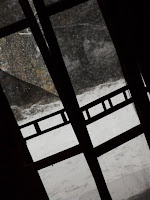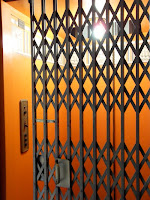
The House That Coke Built
Built in 1920, Chapman J. Root's summer home and surrounding land, which totaled 88 acres has since been parceled off into what we know today as Allendale in southern Terre Haute. Of the original 88-acre property only the 3.5-acre estate remains. The 1920s in Terre Haute enjoyed a surge in prosperity and manufacturing. Root Glass Company was a major producer of glass products until the company designed and manufactured the famous Coca Cola bottle. Mass production and a growing market helped solidify Coca Cola as the refreshment of choice for millions of people worldwide, and helped Terre Haute gain nationwide, if not worldwide, prominence. Chapman J. Root was thrust into a rich and elite society. The familiar green glass and the distinctive shape gave him a large amount of money and prosperity. It is obvious when touring the property that Mr. Root had no issues when spending money, or showing it off.Although many things remain unknown about Rocky Edge, I have gathered several bits of information and stories about Mr. Root's summer play land. Mr. Root considered Rocky Edge as his summer home. He actually lived closer to his factory at Voorhees Street and Highway 41, having residence at 1224 South 6th Street. In the 1920s the trip from the city to Rocky Edge was much more peaceful than today. Terre Haute's south side has been continually expanding. Retail stores and restaurant chains are near the entrance to Allendale, far closer than Chapman Root would have wished.
Fortunately for Allendale residents, topography helps hide most homes and property. Rolling hillsides and heavily wooded land surround Rocky Edge and protect it from the sprawl of Terre Haute. In the mid-1920s, Chapman's estate was secluded from drivers on Highway 41, which was certainly a busy road during that time. Today Highway 41 is heavily traveled, more so than Chapman could have dreamed. Rocky Edge is still secluded, until you drive east into Allendale. Once you are in front of the estate, you realize Mr. Root wanted to show off his wealth, and you would have known all of this was possible because of a familiar green glass.
Mother nature is in charge of Rocky Edge's remnants of lavishness. Floods have washed away several distinctive features of the estate, including the feature that displayed the wealth attained from green glass, and a bottle that is instantly recognizable throughout the world. Carefully built and audaciously positioned in front of the house, Root created a waterfall and pond that stretched across the entire front yard. The concrete foundation, adorned with small tiles and elaborate textures, was then covered by melted green glass. It no longer remains, and it is unclear if it was removed by Root, or washed away by flooding. Perhaps both, but I would imagine it was finally deemed unsafe, especially for children.
Rocky Edge was not just a party house for Root, it was also a play land for children. The estate was described in an e-mail, by a woman who played at the Root farm as a little girl. She swam in the pool and wandered the estate unfettered. She described the zoo, which at the time included a bear, peacocks, a large variety of birds and a cat of some sort. Considering the size of the estate, it certainly would have been a child's dream to play at the farm.
The estate included many water fountains, a detached brick sauna and many aquatic themed tiles, inlaid on the paths that surround Rocky Edge. The 20' x 35', aquatic themed pool is the main feature of the property. The pool was created and built by New York's Lord and Burnham. The same company that created the New York Botannical Gardens.
A large greenhouse and aviary occupy a large section of the property, all built by Lord and Burnham. Elaborate tile work includes tiles from artist Herman Mueller, a famed tile designer in the mid 1920s. Much of the estate was imported, including a large variety of trees. Each tree was carefully placed according to the Root's wishes. If anything could save Rocky Edge, it would be the trees. Someone with more knowledge about trees than myself, would find it interesting. A very large Japanese Maple carefully stands near the front of the house. I have heard that Japanese Maples do not grow very large at all, certainly not as big as those at Rocky Edge.
The interior is a mix of original design and modern design, but it’s easy to understand the original layout and intent for the estate. Originally, there was no staircase leading upstairs, nor a kitchen. Now a staircase leading upstairs from the front entrance greets those lucky enough to see this place. The only access to the upper level was by the elevator or a small spiral staircase near the back of the house. The elevator was quite often the way to go up and down. Servants would help guests, with whatever they wanted, and would have been fixtures during large parties. A tour must have been given for those visiting for the first time.
The entire upper level was a ballroom, up until a previous owner needed living space and created several rooms and the staircase. The ballroom included a powder room, bathrooms and closets. Guests could arrive on the elevator, enjoy the ballroom, and walk around the balcony, which surrounds the upper level. A quick ride down to the bar, and back up to the ballroom would have been a common viewing during a large party.
The indoor pool has sliding doors leading into the house, although the one-way mirror doesn't allow anyone to see into the pool. Above the pool is a hidden room known as the "Prohibition Room", where alcohol was stored for the several parties Chapman would have during the summers. There are a few hidden areas throughout the property, but the “Prohibition Room” is the most telling.
I estimate that at least 20 workers operated the grounds, especially during large gatherings. Year round maintenance was probably done with only a few men. Their duties certainly included maintaining the vast network of pipes that supplied water to the aquatic themed estate. Since there was no kitchen, servants would walk to the Country Club and bring back food on a regular basis.
The Mob, Notables and Stories
Guests of rocky Edge may have included the mob type, rich and powerful. The large guardhouse would have been manned constantly. Halfway up the drive sits a small stone building apparently a waiting area for guests entering or leaving the estate. Looking closely at the structure, you will see a small hatch in the corner, which opens a small room underneath. Steps led from the back of the structure, down into a small valley, seemingly a route to quickly get away.
Whether or not the Root family had ties with the mob, is a question I can't answer. I don't believe they willingly had mob ties. They just had the glory and attraction of Rocky Edge. Root died in 1945 and the estate was sold, mostly in parcels to develop Allendale. Root gave several things to friends and colleagues. He gave Mr. Deming the peacocks, and Tootootch the Totem Pole that currently sits at the Terre Haute Historical Society, once sat in the back yard at Rocky Edge. I am sure there are more items spread throughout Terre Haute that once adorned the landscape of Rocky Edge, I just have no idea where.
In the 1950s and 1960s monks used the estate, and occasionally helped the boy's school across the street, now Gibault School for Boys. They would invite the troubled boys over to the estate, as a retreat from the boys school. I was informed there is a signature atop the elevator shaft, in a small cramped space that only a young child could squeeze into. The signature reads Charles Manson, although I could not verify its existence. It has been said that Charles Manson stayed at the school briefly, and could have visited with the monks.
The estate lies between existence and destruction. Most of the glass-covered areas such as the aviary, greenhouse, and pool are dangerous areas to be. Glass panels have fallen and continue to do so. Over time, weather has taken over some parts of the property. It is merely a shell of what Chapman Jay Root created, although many unique features remain. Rocky Edge is the perfect name for this place, as it now sits on a rocky edge waiting for something to happen. I imagine Mother Nature will decide the fate of the estate.
Chapman Root and his Terre Haute company created the most famous trademark and bottle ever. The historical marker at the original location of his factory, bears an image of the famous contour bottle, and is the only historical marker in the state that bears an image. The bottle will forever be remembered, but the house that Coke built may not withstand the time.

Thanks to all of my sources and friends, including the Terre Haute Historical Society, and the current owners of the property. I have several hundred photos that I need to organize and give to the Historical Society and a better appreciation of Rocky Edge. It's been fun.
All Photos ©2010 Joe Goodrick 4/20/2010
All Photos ©2010 Joe Goodrick 4/20/2010







Hello-I am working on a National Register nomination for Rocky Edge and your posts came up in a google search. You have some information I haven't seen before, but I was wondering if you knew anything of a landscape architect hired to design the site?
ReplyDeleteKurt